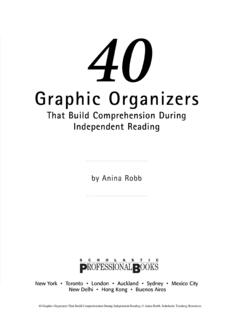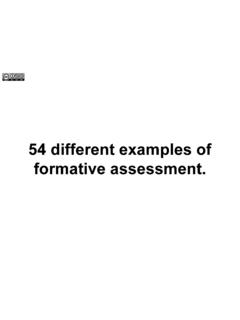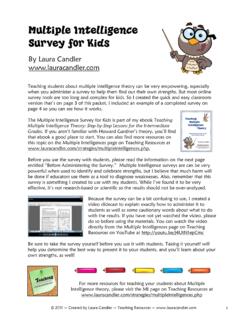Transcription of COOPERATIVE LEARNING STRATEGIES
1 COOPERATIVE LEARNING STRATEGIESA nticipatory SetAdd your thoughts to our KWL chart on COOPERATIVE LEARNING .. =What do you know about CL?=What do you want to know about CL?Then, share any prior experiences of CL with a colleague. Be ready to share ideas with minutesWorkshop ObjectivesBy the end of this workshop, I will be able to: infer the basic elements needed to make COOPERATIVE LEARNING work in MY classroom plan at least three COOPERATIVE LEARNING strategy from seven optionsWhy use COOPERATIVE LEARNING ? promote student LEARNING and academic achievement enhance student satisfaction with their LEARNING experience help students develop skills in oral communication develop social skills & promote student self-esteem help to promote positive race relations can lead to a gain as high as 28 percentiles in measured student achievement (Marzano, Pickering, and Pollock 2001)**.
2 The Five Basic Elements Needed to Make COOPERATIVE LEARNING Interaction The Five Basic Elements Needed to Make COOPERATIVE LEARNING InterdependenceSome Ways to Ensure Positive Interdependence1. One pencil, paper or book given to group2. One paper written for group3. Task divided into jobs; can t finish unless all help4. Pass one paper around group, each person must do their part. Can use different color Jigsaw materials; each person learns a part and then teaches it to the group6. A reward if everyone in the group succeeds7. Use of STAD (keep in mind individual accountability -when I get )The Five Basic Elements Needed to Make COOPERATIVE LEARNING SkillsSome Expected Behaviors to Tell Students1.
3 Everyone contributes and helps 2. Everyone listens to others with care3. Praise helpful actions and good ideas4. Ask for help if you need it (Ask 3 then me)5. Check to make sure that everyone understands6. Stay with your groupGive encouragementRespect othersOn task (stay)Use quiet voicesParticipate activelyStay in our GroupThe Five Basic Elements Needed to Make COOPERATIVE LEARNING Work1. Positive Interdependence2. Social Skills3. Individual AccountabilitySome Ways to Ensure Individual Accountability1. Students do the work first to bring to the group2. Everyone writes, then certifies the correctness of all papers: All students have to hand in something!
4 ! No FREE RIDES3. Assign roles and jobs to each student: MUST DO4. Students get bonus points if all group members do well individually Have to balance group interdependence with accountability Group Roles for Individual Accountability Organizer provides the group with the overall process structure Recorder writes down important information ( , directions or group work) Checker Makes sure that all team members understand the concepts and the team's conclusions. Questioner generates questions and involves all students Assessor evaluates the progress of each work session Encourager models and reinforces appropriate social skills Summarizer - Restates the team's conclusions or Roles Spokesperson represents the group and presents group work to rest of the class Timekeeper keeps group on task and on time Team facilitator Moderates discussions, keeps the team on schedule, ensures that work is completed by all, and makes sure that all have the opportunity to participate and learn.
5 Elaborator Relates the discussion with prior concepts and knowledge. Research runner Gets needed materials and is liaison between teams and between their team and the Norms and Setting Responsibility Individual Responsibility: I am responsible for .. Trying: Improvement countsAsking: Ask for help from teammatesHelping: Offer help to teammatesCourtesy: Make polite requests and show appreciationSupport: Give praisers, encouragers, and build ups (no put downs) Team Responsibility: We are responsible for .. Solving: We try to solve our own problemsTeam Questions: We ask teammates before asking the teacherHelping: We help other teams, classmates, and the teacherInner Voice: We use a voice heard by teammates, but not other teams Dr.
6 Spencer Kagan (watch the youtube KAGAN )The Five Basic Elements Needed to Make COOPERATIVE LEARNING EvaluationSome Ways to Process Group InteractionHow did I / We Do? (Self Assess)SMALL GROUPS did your group do well today? could you do better tomorrow?WHOLE CLASS skills did we do well in working together today? skills could we do even better tomorrow?Some Ways to Process Group InteractionGroup Processing Forms: All Must Do Every TimeINDIVIDUAL (SELF) G*5.@ 161 E<A 1< C299 6; 529=6;4 E<A> 4> <A= G*5.@ 0<A91 E<A 1< 2B2; /2@@2> @<:<>> <C INDIVIDUAL (OTHERS) G!.:2 <;2 @56;4 @ . 4> <A= :2:/2> 161 C5605 529=21 your group?
7 G'299 E<A> 4> <A= :2:/2>? @ E<A .==>206.@21 @526> 529=The Five Basic Elements Needed to Make COOPERATIVE LEARNING Interaction David Johnson and Roger Johnson (1999), Some Ways to Promote Face-to-Face Interaction THINK - PAIR - SHARE: Required Orally explaining how to solve problems Teaching one's knowledge to other Discussing concepts being learned COOPERATIVE LearningWhat Are Your Take Aways for YOUR Situation COOPERATIVE LEARNING Strategies1. Think-Pair-Share (training wheels)2. Quiz-Quiz3. Prairie Fire4. Numbered Heads Together5. Jigsaw**(HL)6. STAD (Student Teams Achievement Division)**(HL)7. Group Investigation (group roles)**(HL) COOPERATIVE LEARNING Strategies2.
8 Quiz-Quiz: Watch video clip and identify the major aspects with a partner and explain how you could customize for your situation. COOPERATIVE LEARNING Strategies2. Quiz-Quiz: SO WHAT? COOPERATIVE LEARNING Strategies2. Quiz-Quiz: Logistics: How would you structure this? Talk with a partner for 5 minutes about the routines you would have to develop to make sure this runs smoothly and does not devolve into a LEARNING Strategies3. Numbered Heads Together: Watch video clip and identify the major aspects with a partner and explain how you could customize for your situation. COOPERATIVE LEARNING Strategies3. Numbered Heads Together: COOPERATIVE LEARNING Strategies3.
9 Numbered Heads Together: NEXT LEVELC ooperative LEARNING Strategies3. Numbered Heads Together: IN-CLASSC ooperative LEARNING Strategies3. Numbered Heads Together: So What?Logistics: How would you structure this? Talk with a partner for 5 minutes about the routines you would have to develop to make sure this runs Time1. Think-Pair-Share (training wheels)2. Quiz-Quiz3. Prairie Fire4. Numbered Heads TogetherChoose 2: 40 minutes plus a break. You can plan with a partner, etc. Think of lessons coming up within the next LEARNING Strategy:JIGSAWSWhat is a JIGSAW?The jigsaw is a COOPERATIVE LEARNING technique with a three-decade track record of successfully increasing positive educational outcomes.
10 Just as in a jigsaw puzzle, each piece--each student's part--is essential for the completion and full understanding of the final product. If each student's part is essential, then each student is essential; and that is precisely what makes this strategy so effective. Social Psychology Network, 2007 Why Use a JIGSAW? To learn a lot of material quickly To hold students individually accountable for LEARNING To maximize student collaboration To encourage higher order and critical thinking skillsJigsaw students into home base the day s lesson, readings, or problems into five each student to learn only one of the five students into expert groups by having one student from each home base group join other students assigned to the same segment.







![[PDF] Differentiated Instruction PPT](/cache/preview/a/c/8/4/8/c/0/6/thumb-ac848c0658649db8874b31455869b542.jpg)


